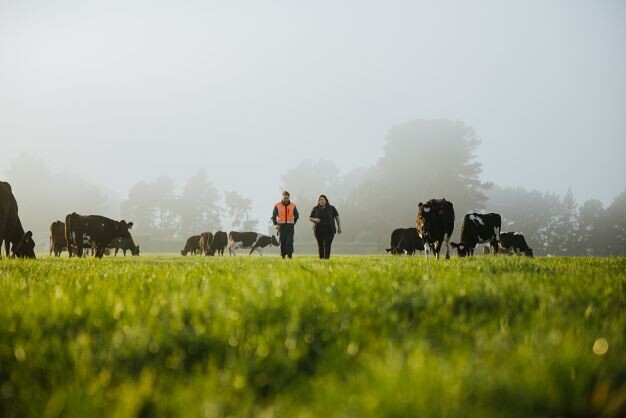With many dairy farmers now experiencing a pasture flush following recent rain, a well-planned Transition feeding regime is even more crucial to minimise the increased risk of milk fever.
As dairy farmers countdown to calving, Transition feeding can help minimise the costs of milk fever on animal health and farmers’ bottom lines.
This was a key message of Nutritech’s Ruminant and Forage Technical Services Manager Nadine Olsen on a recent GrainCorp Feeds webinar.
The webinar is part ofGrainCorp Feeds’ ongoing efforts to educate dairy farmers about Transition feeding as a tool to help improve cow health and lift milk production.
The Transition period covers the four weeks before and after calving and is a critical time for the dairy cow. Getting Transition nutrition right helps enhance rumen function, improve metabolism, boost immunity and reduce the incidence of milk fever.
“If it stays wet through winter, it becomes more challenging to hold cows tight on pasture, which further compounds the risk of milk fever,” says Nadine.
“On the flip side, with more dairy farmers barn feeding springer cows we are seeing significant dietary changes that are changing the risk factors for milk fever, so I strongly encourage dairy farmers to seek good advice on cow nutrition.”
Nadine says transitioning springer cows into high-performing lactating dairy cows is the ultimate goal for farmers.
“Effective Transition feeding can reduce the chance of milk fever setting in post-calving and save farmers time and money.”
The true cost of milk fever
To understand the true cost of milk fever, Nadine talks about the sub-clinical cow being as much of a risk to the bottom line as one that is clinical, or showing obvious signs of milk fever.
She says a clinical cow might lose around $450 worth of milk solids during its treatment phase but the sub-clinical cow, which has not been treated, will also be losing milk.
“They will be low in calcium and could be losing up to a litre of milk a day.”
Studies show there will be 10-15 sub-clinical cows for every clinical cow in a herd. This can mean every cow a farmer treats can cost over $3,200 in lost milk production from both the clinical and sub-clinical cows.
“It’s definitely worthwhile looking at how we can prevent milk fever,” says Nadine. “And it is preventable. We need to be proactive rather than just trying to deal with treating milk fever cows.
“Milk fever is a complex disease and there are multiple factors at play that can help prevent it, including optimum Transition feeding. But getting it right is key. Preventing milk fever is far more cost-effective than treating the problem when it arises”.
Right Feed. Right Time.
Nadine says providing the right feed at the right time can directly improve farmers’ return on investment and improve cows’ overall body condition score.
“When it comes to maintaining optimum levels of magnesium, calcium and Vitamin D, supplementing trace elements, vitamins and antioxidants for springer cows should be standard practice to improve immune function and overall health.
“Another factor to consider is potassium, which can be too high depending on the food source. High levels of potassium prevent a cow from accessing calcium from the bone, which can be the result of eating very lush pasture.
“Feeding hay, straw, maize and wholecrop cereal silages is useful in springer diets to help bring their potassium levels down, as well as dietary protein.”
Lower DCAD (dietary cation anion difference) diets can also increase calcium mobilisation and help to reduce milk fever issues. Reducing DCAD is a nutritional method of stimulating the cow’s own metabolism of calcium reserves.
Transition period critical
GrainCorp Feeds general manager Daniel Calcinai says the transition period is a brief but critically important period.
“During this time, as much as 80 per cent of disease costs are generated, and an average of 4 per cent of animals have to be culled from the herd.
“Farmers know their cows’ demand for nutrients is high at this time of the year. It’s important to set animals up well so they have a smooth calving and minimise the risk of milk fever and other metabolic diseases. That’s what Transition feeding is all about.”
“It can also help prevent other metabolic diseases such as ketosis, retained foetal membrane and lameness, which in turns reduces cost and lifts seasonal profitability significantly,” says Calcinai.
“Getting milk in the vat earlier to reach high peak milk and holding it for longer starts during that Transition period.”
Maximising return on investment
Graincorp Feeds has developed products to help farmers get their Transition nutrition right. The transition product is available in loose or pellet form, to suit a range of applications.
“Despite global supply chain disruptions, the availability of Transition minerals appears strong,” says Calcinai.
“While the price is a little higher than previous years, the return on investment can be significant. Not only the financial return, but also in terms of time saved from not having to treat sick cows, reduced pressure on staff and healthier, more productive animals.
“Every farmer has a different feeding set-up and farming system. So, it’s important they make their Transition feeding plan easy for them and their teams to implement.”
To learn more about Transition feeding and the products GrainCorp offers, visit www.graincorpfeeds.co.nz or call 0800 300 313
